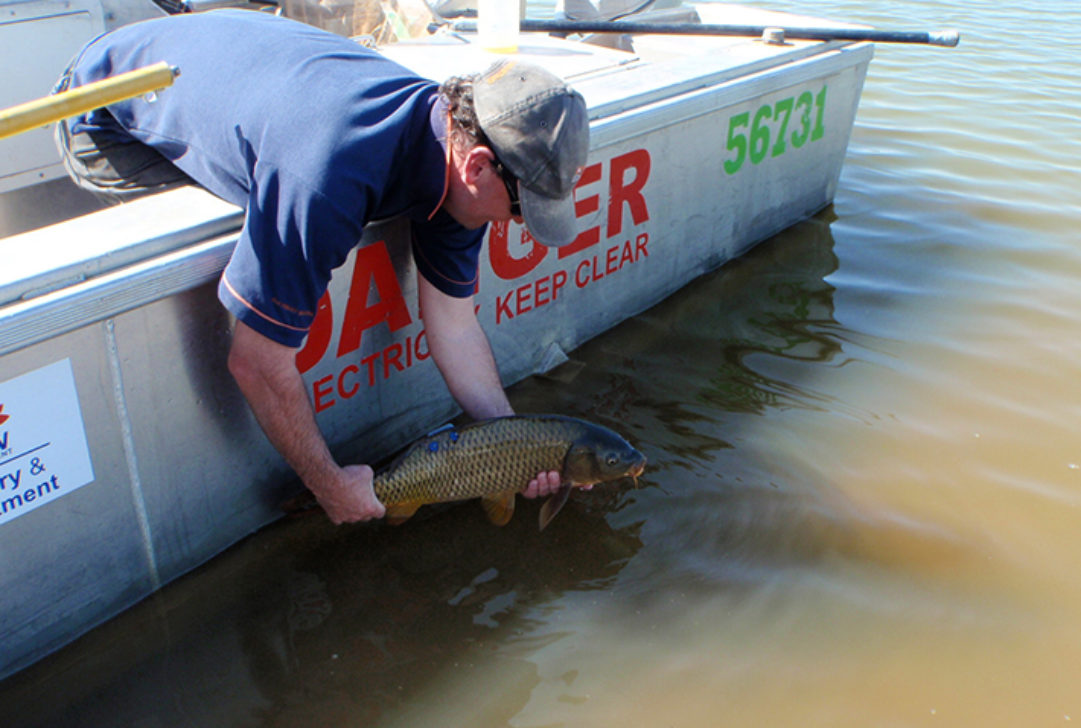Carp (Cyprinus carpio) are one of the most damaging invasive fishes in Australian shallow lakes, wetlands and rivers. Techniques currently available to control this species are generally labour intensive and unlikely to have long-term benefits unless persisted with long-term. An important strategy for the control of carp is to enhance our understanding of their behaviours and vulnerabilities to improve the efficiency of control methods. For example, the success of existing control methods, such as trapping, can be increased by ‘baiting’ traps using various carp-attracting options. This factsheet explores chemical-based environmental and sensory attractants, which may potentially direct carp behaviour and movements.
Technology Update
Carp rely heavily on their sense of smell to obtain information about their environment, and smell plays an important role in their behavioural responses. Pheromones are chemical odours known to bring about behavioral responses between fish of the same species. These behaviours do not need prior experience or learning. Fish employ species-specific pheromones to communicate cues, such as anti-predation and alarm cues, or aggregation cues for both reproductive and non-reproductive purposes. These pheromones can be used in targeted trapping of other carp.
The use of pheromones to guide fish movement is still a relatively new concept, both in Australia and overseas. The development of selective carp pheromones holds promise as a tool for preventing carp population expansion and for population control. Pheromones enhance the effectiveness of carp trapping, but they could also possibly be used to disrupt carp movement and migration patterns, reduce their reproductive success, or to repel individuals.
To manage a targeted fish species using this method, researchers must first identify and characterise the various pheromones of that species, and work out what those pheromones do. Researchers also need to test out the effectiveness and strength of the pheromones in laboratory and field trials.
Pheromones have been used to successfully manage sea lamprey (Petromyzon marinus L.) in the American Great Lakes. Spermiating males were used as sex-pheromone attractants in traps, which resulted in high captures of receptive (ovulating) females. In field conditions, 90% of actively migrating sea lampreys could be drawn into streams treated with a migratory pheromone.
Research by the University of Minnesota, funded by the Invasive Animals Cooperative Research Centre (IACRC), has found that common carp release at least three potentially useful pheromones:
- a male-derived pheromone which specifically attracts receptive females
- a female-derived pheromone which specifically attracts receptive males
- a species-identifying pheromone released by all carp, which compliments the other cues
All of these pheromones can be concentrated and purified, so chemical identification and large-scale application should eventually be possible.
Carp Management
As a first step in developing methods for using these attractants in a trapping program, carp traps have been tested using pheromone and food odours in the laboratory and field. Laboratory studies have found that male carp can be lured into traps using a female pheromone, but only when the male carp are fully mature. When female carp are visible to the males, the activity of the pheromone is increased. Field studies suggest that trap entrances must be designed in a way that allows carp to enter without touching because carp learn from trapping experiences.
Sex-pheromone release in female carp can be triggered by injecting a similar chemical — a synthetic prostaglandin (PGF2α). These females can then be used to lure receptive fish into traps. Direct injection treatment is impractical because PGF2α is metabolised quickly (1–2 hours) and the pheromonal effects are short-lived. Instead, slow release implants loaded with PGF2α can induce pheromone release in female carp for up to two weeks. Field trials have shown male carp are drawn into the vicinity of cage-held female carp that have been implanted with PGF2α3.
The research found that the optimal dose of PGF2α for implantation is 0.4 g/kg of fish. At this dose, the implant is both cost-effective (~$130/fish) and biologically potent. An implanted female can activate a volume of water equivalent to an Olympic swimming pool for two weeks. Higher doses are no more effective and result in high early mortality. Implanted female and male carp release a concentration of PGF2α at least 1000 times greater than naturally ovulated female carp for two weeks.
Carp Pheromone Summary
- Pheromone technology is under development — we need to learn more about pheromone characteristics and function.
- The use of pheromone has minimal impact on non-target species.
- Pheromone may be species- and lifestage-specific.
- Pheromones might be useful in all types of flow conditions, however flow will influence the spread of pheromone.
- Although it is expensive to synthesise pheromone, only a small amount is needed.
- Pheromone is best used in combination with other control techniques such as traps and cages.
- When applied in conjunction with a trap or cage, captured fish need to be regularly removed and disposed of.
- A regular replenishment of pheromone supply is also needed.
- Public safety concerns are not yet known. Chemical use in water may be a concern for environmental protection authority and animal ethics and a risk assessment is required.
References
1. Carp pheromone attractant trials. PestSmart case study, Invasive Animals Cooperative Research Centre, Canberra.
2. Australian Broadcasting Corporation (2010). Sex trap the next weapon against carp. Available at: http://www.abc.net.au/news/2010-11-09/sex-trap-the-nextweapon-against-carp/2330510
3. Lim H and Sorensen P (2010). Making and using female sex pheromone implants which attract mature male common carp. Occasional Report, Invasive Animals Cooperative Research Centre, Canberra.
The authors of these documents have taken care to validate the accuracy of the information at the time of writing. This information has been prepared with care but it is provided “as is”, without warranty of any kind, to the extent permitted by law. The views and opinions expressed in this publication are those of the authors and do not necessarily reflect those of the institutions the authors work for or those who funded the creation of this document.











